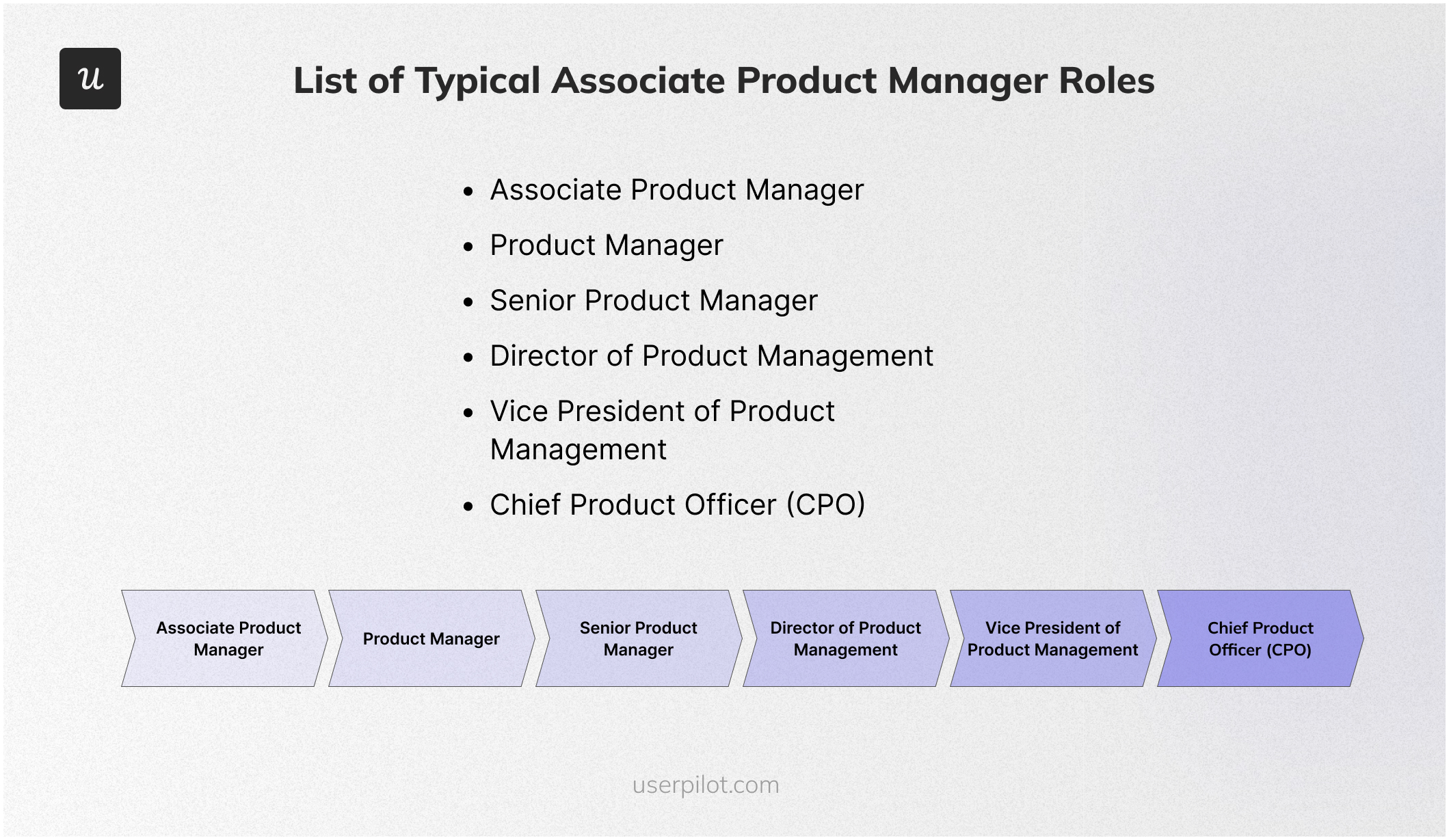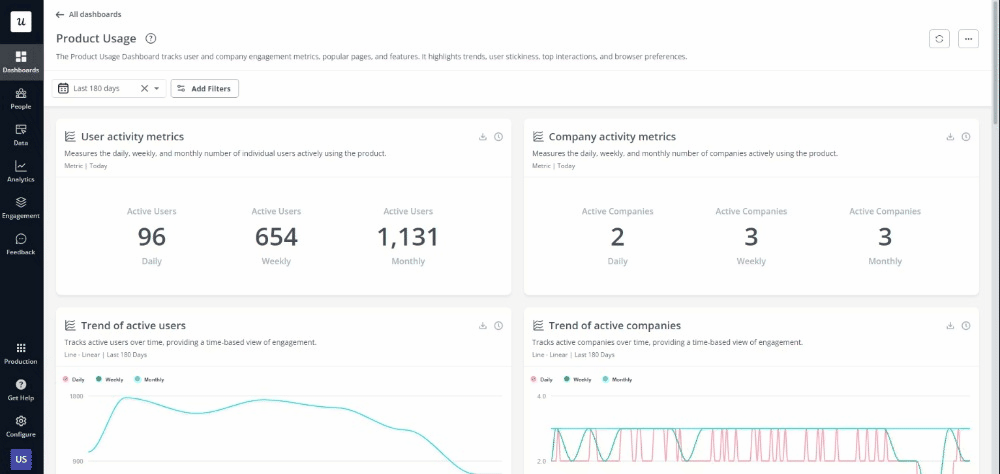![How to Become an Associate Product Manager [+Tools and Resources]](https://blog-static.userpilot.com/blog/wp-content/uploads/2024/07/How-to-Become-an-Associate-Product-Manager-Tools-and-Resources.png)
Try Userpilot Now
See Why 1,000+ Teams Choose Userpilot

Associate product manager’s main responsibilities
As an Associate Product Manager, you play a crucial role in the product lifecycle. Here’s a breakdown of your core responsibilities:
- Product Strategy Development: Assist in crafting and executing product strategies aligned with company goals and market needs. Read more on product strategy.
- Market Research and Analysis: Conduct thorough market research to identify opportunities, customer needs, and competitor activities. Learn how to conduct effective market research.
- Feature Prioritization: Collaborate with senior product managers to prioritize product features and backlog items based on customer feedback and business value. Discover best practices in feature prioritization.
- Cross-functional collaboration: Work closely with engineering, design, and marketing teams to ensure seamless product development and launch processes. Check out strategies for effective collaboration.
- Customer Feedback Integration: Gather and analyze customer feedback to inform product improvements and new feature development. Explore methods for integrating customer feedback.
- Product Roadmap Management: Help create and maintain a detailed product roadmap that aligns with the strategic vision and market demands. Learn more about product roadmapping.
- Data-Driven Decision Making: Use analytics tools to track product performance and user engagement and identify areas for improvement. Leverage insights from data analytics.
- User Experience Optimization: Collaborate with UX/UI designers to ensure the product offers an intuitive and engaging user experience and gain insights into user experience optimization.
- Stakeholder Communication: Regularly update stakeholders on product progress, challenges, and future plans to ensure alignment and support. Learn effective stakeholder communication techniques.
Associate product manager career path
Here is the typical career path for an associate product manager:
- Associate Product Manager: At this initial stage, you’ll work closely with senior product managers to grasp the fundamentals of product lifecycle management. This includes participating in market research, developing product specifications, and managing minor projects. Success in this role is achieved by demonstrating a keen ability to analyze data, understanding customer feedback, and effective communication skills, which are crucial for progressing to more advanced positions.
- Product Manager: Moving up, Product Managers take full responsibility for the success of their products from conception through launch and beyond. This involves more direct involvement in setting product strategy, defining roadmaps, and leading cross-functional teams to execute these plans. To excel, you must continually improve product offerings based on user feedback and performance metrics, enhancing customer satisfaction and business outcomes.
- Senior Product Manager: At the senior level, you’ll oversee multiple product portfolios, mentor junior product managers, and make critical decisions that affect the company’s long-term product strategy. Advancement at this stage is contingent upon your ability to lead and inspire teams, manage complex product challenges, and drive significant growth and innovation within the organization.
- Director of Product Management: As a Director, your focus shifts to a broader product management strategy, including integration of customer insights into product development and alignment with business objectives. The key to success in this role is your capacity to enhance user experience and manage product lines to support the company’s market presence and profitability goals.
- Vice President of Product Management: The VP of Product Management plays a critical role in shaping the company’s product vision at the highest strategic level. Progress in this role depends on your expertise in managing and adapting to market trends, influencing product culture, and making decisions that drive the company forward in competitive and innovative ways.
- Chief Product Officer (CPO): Reaching the pinnacle of the product management career ladder, the CPO is responsible for the company’s entire product strategy. This top executive role demands a visionary approach to product development, a thorough understanding of the market, and the ability to steer the company through shifts in technology and consumer preferences, ensuring sustained business success and market leadership.

How to become an associate product manager?
Ready to start your journey as an Associate Product Manager (APM)? Here are the steps:
- First, obtain a degree in business, marketing, or computer science. As with most careers, getting a basic education is the first step toward becoming a professional in this field.
- Consider adding certifications in product management or agile methodologies to stand out among other college graduates.
- Network with industry experts and attend webinars or in-person events to stay updated on trends.
- Next, gain practical experience through internships or entry-level roles in product management, customer success, or marketing. This will help you to develop crucial skills like data analysis, project management, and communication.
What skills should an associate product manager have?
An Associate Product Manager needs a diverse skill set to contribute to product development and drive successful outcomes effectively. These essential skills include:
- Analytical Thinking: Ability to analyze data, market trends, and customer feedback to make informed product decisions. Mastering data analysis is crucial for identifying opportunities and optimizing product performance.
- Communication: Strong verbal and written communication skills are essential for articulating ideas clearly and collaborating effectively with cross-functional teams. Effective communication skills are vital for ensuring everyone is on the same page.
- Market Research: Conduct thorough market research to understand customer needs, market gaps, and competitive landscape. Learn more about market research techniques to stay ahead of the competition.
- Project Management: Managing timelines, resources, and stakeholders to ensure timely and successful product delivery. Project management skills are essential for keeping projects on track.
- Customer-Centric Mindset: Keeping the customer at the forefront of all product decisions to ensure the product meets their needs and exceeds expectations. Cultivate a customer-centric mindset to drive product success.
- Technical Understanding: Basic understanding of the technical aspects of product development to effectively collaborate with engineering teams. Enhance your technical knowledge to bridge the gap between technical and non-technical stakeholders.
- Problem-Solving: Efficiently identifying and resolving product-related issues to maintain a smooth development process. Strengthen your problem-solving skills to tackle challenges head-on.
- Creativity: Bringing innovative ideas to the table for product features and improvements. Creativity in product innovation can set your product apart from the competition.
Best certifications for associate product managers
Earning a product management certification can validate your knowledge, enhance your skills, and give you an advantage in the job market. However, when choosing which certification to pursue, consider your current experience level and career goals.
Here’s a curated list of top certifications to consider for product managers:
- AIPMM Certified Product Manager®: Offered by the Association of International Product Marketing and Management (AIPMM), this certification validates a candidate’s core product management knowledge and skills. The program covers areas like product strategy, market research, product development, product launch, and product lifecycle management.
- Certified Product Manager (CPM): Bestowed by the Product Management Institute (PMI), this industry-recognized certification validates a candidate’s core product management competencies across the entire product lifecycle. It covers topics like product strategy, user experience, market analysis, and go-to-market planning.
- Professional Scrum Product Owner (PSPO): Offered by Scrum.org, this certification focuses on the role of a product owner within the Scrum framework, a popular Agile methodology for product development. The PSPO curriculum delves into product backlog management, user story creation, sprint planning and retrospectives, and effectively collaborating with Scrum development teams.
- Certified SAFe® 5 Product Owner/Product Manager (PO/PM): This certification, offered by Scaled Agile Framework (SAFe), caters to product managers and owners working within the SAFe enterprise framework for large-scale product development. The curriculum covers topics like SAFe principles, product vision and backlog management, continuous delivery value streams, and navigating dependencies across multiple teams.
- New Product Development Professional (NPDP) by PDMA: This certification is geared towards professionals who want to develop and launch new products successfully. The Product Development and Management Association (PDMA) offers this certification, and it covers the entire new product development process, from ideation and concept development to product launch and post-launch review.
- Product Management with Lean, Agile, and System Design Thinking by EdX and Boston University: This MicroMasters program provides a well-rounded introduction to product management through the lens of Lean, Agile, and Design Thinking methodologies. You’ll gain a strong foundation in product strategy, user research, product development, and product launch. This program is a great option for those who want to earn a recognized credential while learning from a prestigious university. EdX offers this program in collaboration with Boston University.
Best resources for associate product managers
Below, we have compiled a comprehensive list of books, webinars, podcasts, and blogs specifically tailored to enhance the knowledge and skills of Associate Product Managers.
Best books for associate product managers
Starting a career in product management can be daunting, but having the right resources can make a world of difference. These books offer valuable guidance, frameworks, and real-world examples to help aspiring product managers build a strong foundation:
- “Inspired: How To Create Products Customers Love” by Marty Cagan: Practical insights on building successful products by understanding customer needs.
- “Lean Product and Lean Analytics” by Ben Yoskovitz and Alistair Croll: A guide to using data for informed product decisions.
- “The Lean Startup” by Eric Ries: Lean methodology principles for product management.
- “Cracking the PM Interview” by Gayle Laakmann McDowell and Jackie Bavaro: Advice on landing a product management role.
- “Product Management in Practice” by Matt LeMay: Practical advice on the daily responsibilities of a product manager.
Best webinars for associate product managers
Webinars provide an engaging and convenient way to learn from industry experts and stay up-to-date on the latest product management trends and techniques. Here are some of the best webinars tailored for associate product managers:
- Userpilot Webinar Series on Product Management: Industry expert-led webinars on product management.
- “Building Better Products” by Product School: Best practices in product management from experts.
- “Mastering Product Roadmaps” by Mind the Product: Strategies for effective product roadmaps.
- “Product Analytics for Better Decisions” by Mixpanel: Effective use of product analytics tools.
- “Product-Led Growth Strategies” by Userpilot: Webinars on driving growth through product-led strategies.
Best blogs for associate product managers
Blogs offer a wealth of information, from how-to guides to opinion pieces and industry news. These blogs are a great resource for associate product managers seeking to expand their knowledge and stay informed:
- Userpilot Blog: Articles on user experience and product management best practices.
- Mind the Product Blog: Insights, tips, and trends in product management.
- Product Talk by Teresa Torres: Advice on continuous discovery and customer insights.
- Product Coalition: Community-driven blog with articles on all aspects of product management.
- Roman Pichler’s Blog: Insights and advice from a leading product management expert.
Best podcasts for associate product managers
Podcasts are a fantastic way to learn while on the go, offering a wealth of knowledge and insights from experienced product professionals. Here are some of the best podcasts for associate product managers:
- “This is Product Management”: Interviews with product managers and industry leaders.
- “The Product Podcast” by Product School: Insights from top product managers and entrepreneurs.
- Userpilot’s “Product-Led Growth” Podcast: Episodes on creating customer-centric products.
- “The Product Experience”: Stories and tips from product management professionals.
- “Rocketship.fm”: Insights on startups, product management, and growth strategies.
Best tools for associate product managers
Leveraging the right tools is essential to excel as an Associate Product Manager. Here are some top tools tailored to your needs:
- Best tool for user product management – Userpilot: Enables you to track product usage, analyze user behavior, collect user feedback, and create data-driven in-app experiences.
- Best tool for project management – Monday: Facilitates task organization, progress tracking, and timely project delivery, ensuring seamless collaboration.
- Best tool for CX – Zendesk: It provides robust support and feedback management features, helping you address customer concerns promptly and enhance satisfaction.
- Best tool for customer success – ClientSuccess: It tracks customer health metrics and engagement, helping you proactively improve customer retention.
- Best tool for UX/UI design – Figma: Allows collaborative design and prototyping, ensuring intuitive and user-friendly interfaces.
- Best tool for data analytics – Tableau: It offers powerful visualization and analysis capabilities, enabling you to derive actionable insights from data.
- Best tool for collaborative documentation – Confluence: It enhances team collaboration and knowledge sharing, keeping everyone aligned on strategies and updates.
Associate product manager FAQs
Is an associate product manager a leadership role?
An Associate Product Manager (APM) is typically an entry-level or early-career role in product management. It is not generally considered a leadership role. Instead, APMs work closely with more senior product managers and other stakeholders to learn the ropes of product management.
What is the salary of an associate product manager?
The estimated total pay for an Associate Product Manager is $143,246 per year in the United States area, with an average salary of $93,706 per year.
What does an associate product manager do?
Associate Product Managers (APMs) are junior employees who work under experienced product managers and assist them with different tasks such as user research, product performance tracking, or customer feedback analysis.
Conclusion
Becoming a successful associate product manager requires dedication, continuous learning, and a proactive approach to developing relevant skills.
By following the outlined steps and leveraging the resources available, you can effectively navigate your career path and achieve your professional goals.
We hope this guide has provided you with valuable insights and practical advice to help you on your journey to becoming a proficient and impactful associate product manager!
Looking into tools for associate product managers? Userpilot is an all-in-one product platform with engagement features and powerful analytics capabilities. Book a demo to see it in action!







